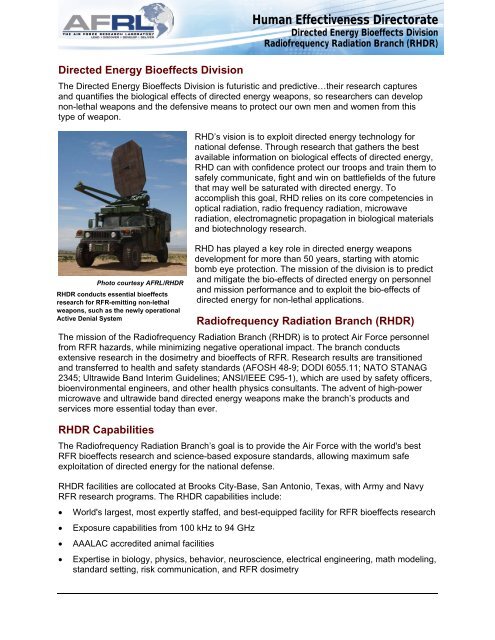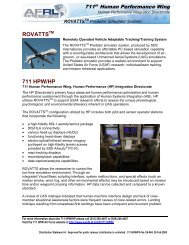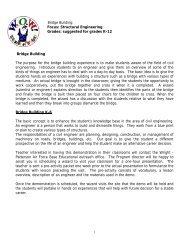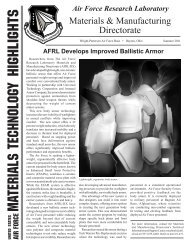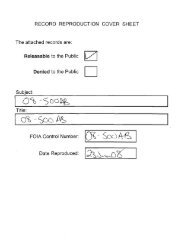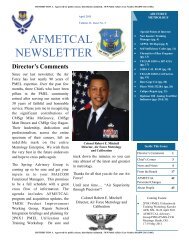Directed Energy Bioeffects Division - Wright-Patterson Air Force Base
Directed Energy Bioeffects Division - Wright-Patterson Air Force Base
Directed Energy Bioeffects Division - Wright-Patterson Air Force Base
Create successful ePaper yourself
Turn your PDF publications into a flip-book with our unique Google optimized e-Paper software.
<strong>Directed</strong> <strong>Energy</strong> <strong>Bioeffects</strong> <strong>Division</strong>Human Effectiveness Directorate<strong>Directed</strong> <strong>Energy</strong> <strong>Bioeffects</strong> <strong>Division</strong>Radiofrequency Radiation Branch (RHDR)The <strong>Directed</strong> <strong>Energy</strong> <strong>Bioeffects</strong> <strong>Division</strong> is futuristic and predictive…their research capturesand quantifies the biological effects of directed energy weapons, so researchers can developnon-lethal weapons and the defensive means to protect our own men and women from thistype of weapon.Photo courtesy AFRL/RHDRRHDR conducts essential bioeffectsresearch for RFR-emitting non-lethalweapons, such as the newly operationalActive Denial SystemRHD’s vision is to exploit directed energy technology fornational defense. Through research that gathers the bestavailable information on biological effects of directed energy,RHD can with confidence protect our troops and train them tosafely communicate, fight and win on battlefields of the futurethat may well be saturated with directed energy. Toaccomplish this goal, RHD relies on its core competencies inoptical radiation, radio frequency radiation, microwaveradiation, electromagnetic propagation in biological materialsand biotechnology research.RHD has played a key role in directed energy weaponsdevelopment for more than 50 years, starting with atomicbomb eye protection. The mission of the division is to predictand mitigate the bio-effects of directed energy on personneland mission performance and to exploit the bio-effects ofdirected energy for non-lethal applications.Radiofrequency Radiation Branch (RHDR)The mission of the Radiofrequency Radiation Branch (RHDR) is to protect <strong>Air</strong> <strong>Force</strong> personnelfrom RFR hazards, while minimizing negative operational impact. The branch conductsextensive research in the dosimetry and bioeffects of RFR. Research results are transitionedand transferred to health and safety standards (AFOSH 48-9; DODI 6055.11; NATO STANAG2345; Ultrawide Band Interim Guidelines; ANSI/IEEE C95-1), which are used by safety officers,bioenvironmental engineers, and other health physics consultants. The advent of high-powermicrowave and ultrawide band directed energy weapons make the branch’s products andservices more essential today than ever.RHDR CapabilitiesThe Radiofrequency Radiation Branch’s goal is to provide the <strong>Air</strong> <strong>Force</strong> with the world's bestRFR bioeffects research and science-based exposure standards, allowing maximum safeexploitation of directed energy for the national defense.RHDR facilities are collocated at Brooks City-<strong>Base</strong>, San Antonio, Texas, with Army and NavyRFR research programs. The RHDR capabilities include:• World's largest, most expertly staffed, and best-equipped facility for RFR bioeffects research• Exposure capabilities from 100 kHz to 94 GHz• AAALAC accredited animal facilities• Expertise in biology, physics, behavior, neuroscience, electrical engineering, math modeling,standard setting, risk communication, and RFR dosimetry
Human Effectiveness Directorate<strong>Directed</strong> <strong>Energy</strong> <strong>Bioeffects</strong> <strong>Division</strong>Radiofrequency Radiation Branch (RHDR)Current RHDR research areasRadiofrequency Radiation Branch bioeffects research examines effects at the sub-cellular,cellular, and whole organism levels. The research is coordinated through the Tri-ServiceElectromagnetic Radiation Panel, which is chartered through the Deputy Undersecretary ofDefense for Environmental Security. In order toexamine carcinogenicity potential, some studiesexpose small laboratory animals to RFR overvirtually their entire life span.Other research focuses on the basicmechanisms of RFR bioeffects. Alsoemphasized are studies on the effects ofmillimeter wave frequency and high powermicrowave radiation on ocular and nervoussystem function. Some new directed energyweapons systems use short, intense pulses ofmicrowave energy to incapacitate opponentelectronic systems. A major research effort isfocused on determining the biological effects ofthese novel pulses in order to establishprotection criteria necessary before thesesystems can be tested and fielded.<strong>Bioeffects</strong> issues are critical to the success ofnew non-lethal weapons. Because of our corebioeffects expertise, we have become a majortest facility for the bioeffects of non-lethalweapons. Our research facilities include:Emitter Systems: VHF, C-band, L-band, S-band, X-band, 35 and 94 GHz, ultra wideband,circular waveguides, and 10 anechoic chambers.Modeling Support: Finite Difference-Time Domain (FT-DT), anatomical visualization, magneticresonance imaging animal models, and mathematical modelingFor more information contact…Office of the Branch ChiefAFRL/RHDR2504 Gillingham DriveBrooks City-<strong>Base</strong>, Texas 78235Phone ......(210) 536-2439DSN .........240-2439Graphic courtesy AFRL/RHDRModeling support is a critical bioeffects issue fordevelopment of non-lethal weapons


